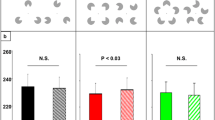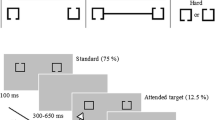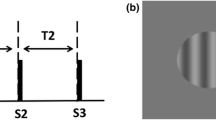Abstract
Closure or the presence of a “hole” is an emergent perceptual feature that can be extracted by the visual system early on. This feature has been shown to have perceptual advantages over openness or “no-hole”. in this study, we investigated when and how the human brain differentiates between “hole” and “no-hole” figures. Event-related potentials (ERPs) were recorded during a passive observation paradigm. Two pairs of simple figures (Experiment 1) and two sets of Greek letters (Experiment 2) were used as stimuli. The ERPs of “hole” and “no-hole” figures differed ∼90 ms after stimulus onset: “hole” figures elicited smaller P1 and N1 amplitudes than “no-hole” figures. These suggest that both P1 and N1 components are sensitive to the difference between “hole” and “no-hole” figures; perception of “hole” and “no-hole” figures might be differentiated early during visual processing.
Similar content being viewed by others
References
Chen L. Topological structure in visual perception. Science 1982, 218: 699–700.
Chen L. Holes and wholes: a reply to Rubin and Kanwisher. Percept Psychophys 1990, 47: 47–53.
Chen L. The topological approach to perceptual organization. Vis Cogn 2005, 12: 553–701.
Zhuo Y, Zhou TG, Rao HY, Wang JJ, Meng M, Chen M, et al. Contributions of the visual ventral pathway to long-range apparent motion. Science 2003, 299: 417–420.
Kimchi R. Primacy of wholistic processing and global/local paradigm: a critical review. Psychol Bull 1992, 112: 24–38.
Kimchi R. The role of wholistic/configural properties versus global properties in visual form perception. Perception 1994, 23: 489–504.
Kimchi R, Bloch B. Dominance of configural properties in visual form perception. Psychon Bull Rev 1998, 5: 135–139.
Turati C, Simion F, Zanon L. Newborns’ perceptual categorization for closed and open geometric forms. infancy 2003, 4: 309–325.
Donnelly N, Humphreys GW, Riddoch MJ. Parallel computation of primitive shape descriptions. J Exp Psychol Hum Percept Perform 1991, 17: 561–570.
Pomerantz JR, Sager LC, Stoever RJ. Perception of wholes and of their component parts: some configural superiority effects. J Exp Psychol Hum Percept Perform 1977, 3: 422–435.
Treisman A, Paterson R. Emergent features, attention, and object perception. J Exp Psychol Hum Percept Perform 1984, 10: 12–31.
Zhang J, Zhu W, Ding X, Zhou C, Hu X, Ma Y. Different masking effects on “hole” and “no-hole” figures. J Vis 2009, 9: 6.1–14.
Bertamini M, Lawson R. Visual search for a circular region perceived as a figure versus as a hole: evidence of the importance of part structure. Percept Psychophys 2006, 68: 776–791.
Bertamini M. Who owns the contour of a visual hole? Perception 2006, 35: 883–894.
Komatsu H, ideura Y. Relationships between color, shape, and pattern selectivities of neurons in the inferior temporal cortex of the monkey. J Neurophysiol 1993, 70: 677–694.
Rossion B, Joyce CA, Cottrell GW, Tarr MJ. Early lateralization and orientation tuning for face, word, and object processing in the visual cortex. Neuroimage 2003, 20: 1609–1624.
Thorpe S, Fize D, Marlot C. Speed of processing in the human visual system. Nature 1996, 381: 520–522.
VanRullen R, Thorpe SJ. The time course of visual processing: from early perception to decision-making. J Cogn Neurosci 2001, 13: 454–461.
Jeffreys DA. Evoked studies of face and object processing. Vis Cogn 1996, 3: 1–38.
Rossion B, Gauthier i, Tarr MJ, Despland P, Bruyer R, Linotte S, et al. The N170 occipito-temporal component is delayed and enhanced to inverted faces but not to inverted objects: an electrophysiological account of face-specific processes in the human brain. Neuroreport 2000, 11: 69–74.
Large ME, Kiss i, McMullen PA. Electrophysiological correlates of object categorization: back to basics. Brain Res Cogn Brain Res 2004, 20: 415–426.
Tanaka J, Luu P, Weisbrod M, Kiefer M. Tracking the time course of object categorization using event-related potentials. Neuroreport 1999, 10: 829–835.
Pernet C, Basan S, Doyon B, Cardebat D, Demonet JF, Celsis P. Neural timing of visual implicit categorization. Brain Res Cogn Brain Res 2003, 17: 327–338.
Zhou K, Luo H, Zhou T, Zhuo Y, Chen L. Topological change disturbs object continuity in attentive tracking. Proc Natl Acad Sci U S A 2010, 107: 21920–21924.
Chen L, Zhang S, Srinivasan MV. Global perception in small brains: topological pattern recognition in honey bees. Proc Natl Acad Sci U S A 2003, 100: 6884–6889.
Zhang J, Zhu W, Ding X, Zhou C, Hu X, Ma Y. Configural processing of different topologically structured figures: an ERP study. Sci China C Life Sci 2009, 52: 1198–1204.
Thierry G, Martin CD, Downing P, Pegna AJ. Controlling for interstimulus perceptual variance abolishes N170 face selectivity. Nat Neurosci 2007, 10: 505–511.
Dering B, Martin CD, Thierry G. is the N170 peak of visual event-related brain potentials car-selective? Neuroreport 2009, 20: 902–906.
Elder J, Zucker S. The effect of contour closure on the rapid discrimination of two-dimensional shapes. Vision Res 1993, 33: 981–991.
Tarkiainen A, Cornelissen PL, Salmelin R. Dynamics of visual feature analysis and object-level processing in face versus letter-string perception. Brain 2002, 125: 1125–1136.
Johnson JS, olshausen BA. Timecourse of neural signatures of object recognition. J Vis 2003, 3: 499–512.
Curran T, Tanaka JW, Weiskopf DM. An electrophysiological comparison of visual categorization and recognition memory. Cogn Affect Behav Neurosci 2002, 2: 1–18.
Low A, Bentin S, Rockstroh B, Silberman Y, Gomolla A, Cohen R, et al. Semantic categorization in the human brain: spatiotemporal dynamics revealed by magnetoencephalography. Psychol Sci 2003, 14: 367–372.
Meng QL, Wang B, Liu N, Ma YY. Topological perception of different age people. Acta Biophys Sin 2006, 22: 87.
Bentin S, Allison T, Puce A, Perez E, McCarthy G. Electrophysiological studies of face perception in humans. J Cogn Neurosci 1996, 8: 551–565.
Eimer M. Effects of face inversion on the structural encoding and recognition of faces. Evidence from event-related brain potentials. Brain Res Cogn Brain Res 2000, 10: 145–158.
Itier RJ, Taylor MJ. N170 or N1? Spatiotemporal differences between object and face processing using ERPs. Cereb Cortex 2004, 14: 132–142.
Itier RJ, Taylor MJ. Effects of repetition and configural changes on the development of face recognition processes. Dev Sci 2004, 7: 469–487.
Itier RJ, Taylor MJ. Face recognition memory and configural processing: a developmental ERP study using upright, inverted, and contrast-reversed faces. J Cogn Neurosci 2004, 16: 487–502.
Linkenkaer-Hansen K, Palva JM, Sams M, Hietanen JK, Aronen HJ, ilmoniemi RJ. Face-selective processing in human extrastriate cortex around 120 ms after stimulus onset revealed by magneto- and electroencephalography. Neurosci Lett 1998, 253: 147–150.
Taylor MJ, Batty M, Itier RJ. The faces of development: a review of early face processing over childhood. J Cogn Neurosci 2004, 16: 1426–1442.
Boehm SG, Dering B, Thierry G. Category-sensitivity in the N170 range: a question of topography and inversion, not one of amplitude. Neuropsychologia 2011, 49: 2082–2089.
Itier RJ, Latinus M, Taylor MJ. Face, eye and object early processing: what is the face specificity? Neuroimage 2006, 29: 667–676.
Author information
Authors and Affiliations
Corresponding author
Rights and permissions
About this article
Cite this article
Zhu, W., Zhang, J. & Zhou, C. Time-course of perceptual processing of “hole” and “no-hole” figures: An ERP study. Neurosci. Bull. 29, 47–57 (2013). https://doi.org/10.1007/s12264-012-1290-y
Received:
Accepted:
Published:
Issue Date:
DOI: https://doi.org/10.1007/s12264-012-1290-y




